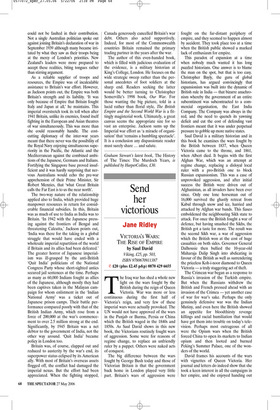Send her victorious
Jane Ridley
VICTORIA’S WARS: THE RISE OF EMPIRE by Saul David Viking, £25, pp. 503, ISBN 9780670911387 ✆ £20 (plus £2.45 p&p) 0870 429 6655 The Iraq war has shed a whole new light on the wars fought by the British during the reign of Queen Victoria. War was more or less continuous during the first half of Victoria’s reign, and very few of these imperial wars were actually provoked. The UN would not have approved of the wars in the Punjab or Burma, Persia or China which the British waged in the 1840s and 1850s. As Saul David shows in this new book, the Victorians routinely fought wars of aggression. Some were for reasons of regime change, to replace an unfriendly ruler by a puppet. Others were naked acts of conquest.
The big difference between the wars fought by George Bush today and those of Victorian Britain is that the government back home in London played very little part. Britain’s wars of aggression were fought on the far-distant periphery of empire, and they seemed to happen almost by accident. They took place too at a time when the British public showed a marked lack of enthusiasm for empire.
This paradox of expansion at a time when nobody much wanted it has long puzzled historians. One answer is to blame the man on the spot, but that is too easy. Christopher Bayly, the guru of global historians, has argued convincingly that expansionism was built into the dynamic of British rule in India — that bizarre anachronism whereby the government of an entire subcontinent was subcontracted to a commercial organisation, the East India Company. The Company was always in the red, and the need to quench its yawning deficit and cut the cost of defending vast frontiers meant that it was under perpetual pressure to gobble up more native states.
Saul David is a military historian and in this book he examines the wars fought by the British between 1837, when Queen Victoria came to the throne, and 1861, when Albert died. It begins with the first Afghan War, which was an attempt at regime change, replacing a disloyal local ruler with a pro-British one to block Russian expansionism. This was a case of unprovoked aggression, and after initial success the British were driven out of Afghanistan, as all invaders have been ever since. Only one lone horseman out of 16,000 survived the ghastly retreat from Kabul through snow and ice, harried and attacked by Afghan war bands. This fiasco emboldened the neighbouring Sikh state to attack. For once the British fought a war of defence, but having smashed the Sikhs, the British got a taste for more. The result was the second Sikh war, a war of aggression which the British won at the cost of huge casualties on both sides. Governor General Dalhousie then bullied the 10-year-old Maharaja Dalip Singh into abdicating in favour of the British as well as surrendering the priceless Koh-i-noor diamond to Queen Victoria — a truly staggering act of theft.
The Crimean war began as a response to Russia’s invasion of the Turkish empire. But when the Russians withdrew the British and French pressed ahead with an invasion of the Crimea — yet another case of war for war’s sake. Perhaps the only genuinely defensive war was the Indian Mutiny, and even here the British showed an appetite for bloodthirsty revenge killings and racial humiliation that would have got them into trouble on today’s television. Perhaps most outrageous of all were the Opium wars when the British forced China to open its markets to Indian opium and then looted and burned Peking’s Summer Palace, one of the wonders of the world.
David frames his accounts of the wars with vignettes of Queen Victoria. Her journal and letters do indeed show that she took a keen interest in all the campaigns in her empire, and she enjoyed handing out medals such as the Victoria Cross, which was invented during the Crimean war. It’s true that she goaded her ministers to get on with suppressing the Indian Mutiny, but there’s no reason to suppose that she was behind the wars of aggression. David doesn’t actually say as much, but by constantly alluding to her he gives a misleading impression that somehow she was responsible.
Saul David makes war interesting even for the non-military buff, and his accounts of such set pieces as the Charge of the Light Brigade or the sieges of the Indian Mutiny have a freshness which is due in part to his reliance on unpublished documents. This brisk and lucid narrative is a timely reminder that the British in their imperial heyday were no better than the Americans today.











































































































 Previous page
Previous page